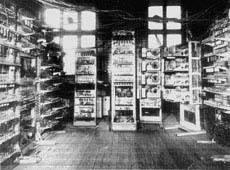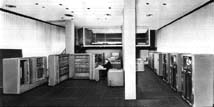Now that electronics has made sufficient progress and the first computers have proven, computers will be able to appear, arose from the need to make operations more complex.
 December 1947 : Invention of the transistor by Shockley William Bradford , Walter H. Brattain and John Bardeen at Bell Telephone Laboratories. December 1947 : Invention of the transistor by Shockley William Bradford , Walter H. Brattain and John Bardeen at Bell Telephone Laboratories. |
 January 1948 : Wallace Eckert at the IBM team and complete the SSEC (Selective Sequence Electronic Calculator). This hybrid machine is composed of multiple storage systems: eight vacuum tubes, 150 words on a memory relay and 66 loops paper tape can store a total of 20,000 words of 20 digits in BCD format. This machine could read its instructions from one of the loops of paper, even in memory, which is also a calculator program stored (even if the memory was minimal). From the point of view of IBM , so it is the first real computer. January 1948 : Wallace Eckert at the IBM team and complete the SSEC (Selective Sequence Electronic Calculator). This hybrid machine is composed of multiple storage systems: eight vacuum tubes, 150 words on a memory relay and 66 loops paper tape can store a total of 20,000 words of 20 digits in BCD format. This machine could read its instructions from one of the loops of paper, even in memory, which is also a calculator program stored (even if the memory was minimal). From the point of view of IBM , so it is the first real computer. |
 June 1948 : NewMan , Williams and their team at the University of Manchester completing a prototype machine called the Manchester Mark I with a new type of memory consists of tubes: to store a bit of information, a cathode ray lighting a point on the tube was left switched on. To read it, it was enough to point the beam at the same place and make a voltage measurement with an electrode placed on the other side of the tube! The Mark I had a memory and 1024 bits into a single tube. June 1948 : NewMan , Williams and their team at the University of Manchester completing a prototype machine called the Manchester Mark I with a new type of memory consists of tubes: to store a bit of information, a cathode ray lighting a point on the tube was left switched on. To read it, it was enough to point the beam at the same place and make a voltage measurement with an electrode placed on the other side of the tube! The Mark I had a memory and 1024 bits into a single tube.The machine was programmed (in binary form) with the stored program and the results were read on another tube in binary. It is true that the first computer. |
September 1948 : The ENIAC is improved by adding a table of predefined instructions. The program entered the ENIAC could therefore use each of these instructions. We can consider that this modification transforms the ENIAC computer in, even if the program is still entered by rewiring.
 May 1949 : Maurice V. Wilkes and his team at the University of Cambridge are developing the EDSAC (Electronic Delay Storage Automatic Computer) based on the design EDVAC of Von Neuman . Memory, of a size of 512 words of 17 bits, consisted of mercury delay lines. Storing the bits were converted into ultrasonic waves and transmitted to the end of a mercury reservoir. Recaptés they were at the other end and reissued. Only bits were available in electrical form.This system was slower but more reliable than static tubes. May 1949 : Maurice V. Wilkes and his team at the University of Cambridge are developing the EDSAC (Electronic Delay Storage Automatic Computer) based on the design EDVAC of Von Neuman . Memory, of a size of 512 words of 17 bits, consisted of mercury delay lines. Storing the bits were converted into ultrasonic waves and transmitted to the end of a mercury reservoir. Recaptés they were at the other end and reissued. Only bits were available in electrical form.This system was slower but more reliable than static tubes.The clock speed of the machine was 0.5 MHz and the inputs and outputs were effected by paper tape. The software supported the relocatable code at load time for each program. |
August 1949 : P. Eckert and J. Mauchly , who formed their own company, develop the first computer dual-processor : the Binac for the U.S. Navy. Both processors were doing the same operations in parallel to increase the reliability of the calculations.
 1949 - 1951 : First computer real time: Whirlwind created at MIT by Jay Forrester , Ken Olsen and their team. Research performance, reliability and speed of response in this computer have brought great progress. This machine was also the prototype of the computers used for computer network defense American SAGE (Semi Automated Ground Environment). 1949 - 1951 : First computer real time: Whirlwind created at MIT by Jay Forrester , Ken Olsen and their team. Research performance, reliability and speed of response in this computer have brought great progress. This machine was also the prototype of the computers used for computer network defense American SAGE (Semi Automated Ground Environment). |
1950 : The calculator Konrad Zuse , the Z4 made during the war, eventually rose to the Zurich Polytechnic and modified to perform jumps and conditional branches. When running a program, two instructions were read and preprocessed in advance. This is the first implementation of a pipeline in a computer. The machine will be used until 1955 and then transferred to France and used until 1960.
1950 : Invention of the assembler by Maurice V. Wilkes of the University of Cambridge. Before programming was done directly in binary.
 January 1951 : Creation of the first Soviet computer MESM under the direction of Sergei Lebedev Alexeevich the Academy of Sciences of Ukraine. January 1951 : Creation of the first Soviet computer MESM under the direction of Sergei Lebedev Alexeevich the Academy of Sciences of Ukraine. |
1951 : The Compagnie des Machines Bull made his first computer: Gamma 2 .
 1951 : Development of the drum mass magnetic ERA in 1101 . This is the first mass memory. Capacity: 1 Mbits. 1951 : Development of the drum mass magnetic ERA in 1101 . This is the first mass memory. Capacity: 1 Mbits. |
1951 : Invention of the first compiler A0 by Grace Murray Hopper to generate a binary from source code.
1952 : The Compagnie des Machines Bull markets the Gamma 3 which won a great success: a thousand copies will be built.
 1952 : IBM produced its first computer, the IBM 701 to the American defense. 19 copies will be produced. This machine had a memory of 2048 CRT or 4096 words of 36 bits and could perform 16,000 additions or 2200 multiplications per second. The first machine will be installed at Los Alamos (see photo) for the proposed thermo-nuclear bomb U.S.. 1952 : IBM produced its first computer, the IBM 701 to the American defense. 19 copies will be produced. This machine had a memory of 2048 CRT or 4096 words of 36 bits and could perform 16,000 additions or 2200 multiplications per second. The first machine will be installed at Los Alamos (see photo) for the proposed thermo-nuclear bomb U.S.. |
1952 : IBM is contacted to start work on the production network computers SAGE whose Whirlwind was the prototype. Fifty machines, named AN/FSQ7 will be produced. Each machine contained 75,000 tubes, weighed 275 tons and consumed 750 kWh.
1952 : The first computer French, CUBA (Universal Binary Calculator Armament), was built by the company SEA .
 July 1953 : IBM launches its first commercial computer in series: the IBM 650 , designed to be compatible with accounting machines mechanical punch card brand.Though slow, unreliable as it is based on the technology of vacuum tubes and expensive, a thousand copies will be produced. This will be the first computer many American universities thanks to big discounts by IBM in order to familiarize students with computers and especially the possible future customer loyalty. July 1953 : IBM launches its first commercial computer in series: the IBM 650 , designed to be compatible with accounting machines mechanical punch card brand.Though slow, unreliable as it is based on the technology of vacuum tubes and expensive, a thousand copies will be produced. This will be the first computer many American universities thanks to big discounts by IBM in order to familiarize students with computers and especially the possible future customer loyalty. |
 1953 : Invention of the ferrite core memory in the Whirlwind which advantageously replace all unreliable systems used until now. 1953 : Invention of the ferrite core memory in the Whirlwind which advantageously replace all unreliable systems used until now. |
1955 : First computer network for commercial purposes: SABRE (Semi-Automated Business Related Environment) made by IBM . It connects TTY 1200 through the United States for booking flights withAmerican Airlines .
 1955 : IBM launches the IBM 704 developed by Gene Amdahl . This is the first commercial machine with a math coprocessor. Power: 5 kFLOPS (thousand floating point operations per second). It is often assumed that the machine marks the beginning of the era of supercomputers dedicated to scientific computing. It used a ferrite core memory of 32,768 words of 36 bits and was three times faster than the IBM 701 . With ferrite cores, this machine was very reliable (for the time) and fell down once a week :-) It was on this machine that will be developed language FORTRAN . 1955 : IBM launches the IBM 704 developed by Gene Amdahl . This is the first commercial machine with a math coprocessor. Power: 5 kFLOPS (thousand floating point operations per second). It is often assumed that the machine marks the beginning of the era of supercomputers dedicated to scientific computing. It used a ferrite core memory of 32,768 words of 36 bits and was three times faster than the IBM 701 . With ferrite cores, this machine was very reliable (for the time) and fell down once a week :-) It was on this machine that will be developed language FORTRAN . |

